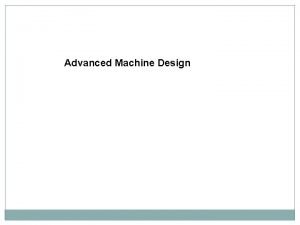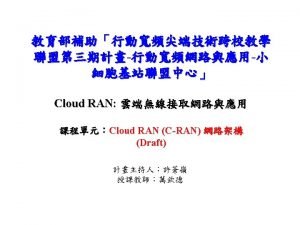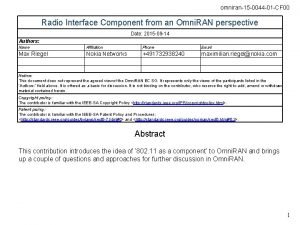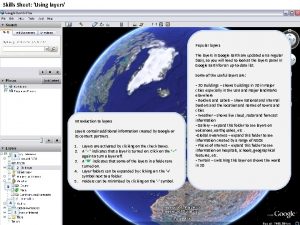Chapter6 Access Network Design Topics Network Design Layers

















- Slides: 17

Chapter-6 Access Network Design

Topics §Network Design Layers §Application layer §Premises Architecture or Local Enterprise Architecture Layer §Access layers §Backbone Layers §Access Layer design §Network Topology and Hardware §Ubiquitous Access §Hierarchical Access

Network Design Layers The four general layers of Network design§Application §Access §Premises §Back bone

Network Design Layers Summary of Cisco model§Core: this is the core or backbone of the network. the core to be reliable and fast. No filtering or packet manipulation is done so as not to affect speed. §Distribution: as the core layer is about speed, the distribution layer is about control. The distribution layer implements network policies of security. §Access: access controls user and workgroup to the network

Network Design Layers

Application Layer Application layer defines what is transported and how. The application layer defines the various protocols( TCP/IP) and the services(DNS, DHCP, FTP and NFS) that the lower layer protocol need to support and transport. Application layer covers all the OSIRM layers, not just the application layer

Premises Architecture or Local Enterprise Architecture Layer This layers defines the hardware and software that make up the desktop, servers and local area networking within a premises. This layer can operate across all the OSIRM layers

Access Layer This layer defines the premises layer access or interface to the back bone layer or WAN and communication between the premises layer (typically LAN)and backbone(WAN). A typical access device could be a router , L 2 switch(FR, ATM, Ethernet) integrated access device cable , wireless modem or any device that provides communication between the premises and the backbone

Backbone Layer This layers defines the backbone transport, switching , and routing between access layer elements. It is generally transparent to the access portion of the network. To the user , the backbone can be a carrier-provided switched device

Access Layer Design Access layers design involves selecting or modifying the LAN, MAN, dial or dedicated access topology. Before beginning the process of traffic analysis , capacity planning, and network infrastructure design, You first need to assess information you have collected in five key areas -

Access Layer Design…. . §Physical connectivity: is there an existing network? If so , what are the physical and logical configuration and why ? §Protocols: Networks that have been around for long time are typically multiprotocol and require some consolidation for optimal design §Switching versus routing: Do you have LAN switches, routers or both ? When and where does make sense to switch and route ? §Qo. S: which application need to support Qo. S, and what level of Qo. S do they need. §Fix versus mobiles SOHO: how many users are fixed on corporate LANs require mobiles access ?

Network Topology and Hardware The Network topology for the access layer includes LAN, remote access, and dedicated access method. When reviewing options, keep in mind the following- §Scalability and flexibility §Reliability and availability §Performance §Security

Network Topology and Hardware The Network topology for the access layer includes LAN, remote access, and dedicated access method. When reviewing options, keep in mind the following- §Scalability and flexibility §Reliability and availability §Performance §Security

Ubiquitous Access approach allow all users to transmit and receive data from all areas of the network across a shared device or medium. This is sometimes called the matrix or flat approach.

Ubiquitous Access

Hierarchical Access Hierarchical design provided a user access hierarchy in which traffic destined for its own local , metropolitan and wide area remains in that geographical area rather than accessing common switch or routing point to the backbone.

Hierarchical Access
 Terminal access controller access control system
Terminal access controller access control system Terminal access controller access-control system
Terminal access controller access-control system Interesting topics in network security
Interesting topics in network security Pertanyaan untuk pemateri seminar
Pertanyaan untuk pemateri seminar Machine design topics
Machine design topics Network systems design using network processors
Network systems design using network processors Layers in security architecture design
Layers in security architecture design Juniper network access control
Juniper network access control Access network adalah
Access network adalah Nac remediation
Nac remediation Health access network
Health access network Simultaneous access in network
Simultaneous access in network Centralized radio access network
Centralized radio access network Access network architecture
Access network architecture All partners access network
All partners access network Que es beacon
Que es beacon Open access fibre network
Open access fibre network National network of child psychiatry access programs
National network of child psychiatry access programs

































